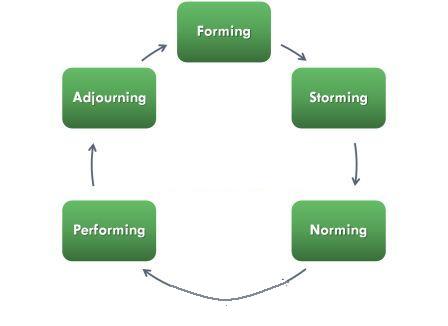When a number of individuals begin to work at interdependent jobs, they often pass through several stages as they learn to work together as a team. The stages of team development life cycle are forming, storming, norming, performing, and adjourning. This model of team development was first proposed by Bruce Tuckman in 1965, who maintained that these phases are all necessary and inevitable and allow team growth.
Though these are not followed rigidly, they do represent a broad pattern that may be observed and predicted in many settings across team’s time together. These stages are the result of a variety of questions and issues that team members face such as “who will be members of the team?” “Who will perform what functions?” “Who will contribute what?” “What rules will be followed?” “How can conflicts among members be resolved?” and so on.
These typical stages of team development life cycle are described below:
- Forming: At the first stage of the life cycle, team members get introduced to each other if they have not interacted earlier. They share personal information, start to accept others, and begin to turn their attention to the group tasks. At this stage, interaction among team members is often cautious especially when they are new to one another.
- Storming: After the forming stage which is mostly related to perceiving and assessing each other, members start interaction among themselves in the form of competing for status, jockeying for relative control, and arguing for appropriate strategies to be adopted for achieving team’s goals, because of individual differences, different members may experience varying degree of tension and anxiety out of this interaction pattern.
- Norming: After storming stage, team members start settling. The team begins to move in a co-operative fashion and a tentative balance among competing forces too is struck. At this stage, group norms emerge to guide individual behavior which form the basis for co-operative feelings and behavior among members.
- Performing: When team members interact among themselves on the basis of norms that have emerged in the team, they learn to handle complex problems that come before the team. Functional roles are performed and exchanged as needed, and tasks are accompanied efficiently.
- Adjourning: Adjourning is the end phase of cycle of a team. Sooner or later, each team has to be adjourned, even the most successful teams as they have completed their mission. The adjournment phase takes place in the case of those teams which are created for some special purposes like task force, committee, etc. Other types of team like a department in an organization run on the basis of some permanency though there may be changes in team members. After the adjournment of the team, intense social relationship among members comes to an end.
It is not necessary that all teams follow the rigid pattern of team development life cycle prescribed here and the similar problems they face at each stage because each team is different in some respect based on the type of members and problems and functions assigned. However, concept of team development life cycle is significant in the context of the nature of problem which team members are likely to face in team-work.
External Links:
- Using the Stages of Team Development (MIT Human Resources)
